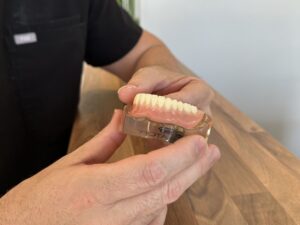
In today’s Australian culture, a nice, beautiful smile is becoming more and more important, not only for its part in oral health but also for its influence on self-esteem and general health. Cosmetic dentistry has changed so much, and today’s cosmetic dentist has at his or her disposal a host of techniques and procedures to make teeth and gums as pretty as the patient would like them to be. Among the great innovations in modern dentistry are dental implants, an enduring, natural-looking answer to missing teeth, and a full range of dental restoration methods designed to mend and enhance smiles.
For Australians thinking about these next-level treatments, there is much to know – options, processes, and what to look for in a provider. This resource offers an authoritative guide to the principles and techniques of cosmetic dentistry in Australia and New Zealand and to the treatment of specific restorative and orthodontic cases from an internationally renowned panel of contributors.
The Horizons of Cosmetic Dentist in Australia
Cosmetic dentistry is a subsection of dentistry that mainly deals with the enhancement of the aesthetic appearance of a person’s teeth, gums, and smile. Although there are several other benefits to it as well, in most cases, people want it done for a better appearing smile.
What Can a Cosmetic Dentist Do?
There are various cosmetic dentist in Australia who offer a broad range of treatments that cater to some of your aesthetic concerns. The most common type of treatment is teeth whitening to whiten the natural colour of teeth. Porcelain veneers, thin shells made in a lab and bonded to the front surface of teeth, can address discolouration, chips, gaps, or slight misalignment. Composite bonding—composite bonding is when a plastic resin that is the colour of your teeth is directly applied to the surface of the tooth itself to repair chipped teeth, narrow the gaps between teeth, or alter the shape of teeth.
Gum contouring, or reshaping, can eliminate a ‘gummy smile’ or improve an uneven gum line. Orthodontic treatment aims to straighten out crooked teeth using conventional fixed teeth braces and the increasingly popular clear aligner systems, such as Invisalign, to provide a major enhancement to the aesthetics of the smile. For more complete makeovers, a cosmetic dentist may perform full smile makeovers, which use a combination of treatment techniques to give the patient a new look. Please note, a large proportion of general dentists in Australia deliver a variety of cosmetic treatments, and some have a strong focus or additional training in this field.
The Art and Science of the Perfect Smile
Contemporary cosmetic dentistry from Australia in 2025 is an art form combined with science. It is not limited to simply whitening and straightening teeth; it is about harmonising a smile with the face, age, and personality of the patient. These days, advanced tools like DSD (Digital Smile Design) are being used more and more. Digital smile design (DSD) comprises digital photography, video analysis and special computer software to carefully plan and model the cosmetic treatments that patients might opt for and hence, see and become involved in the new smile design before anything else is started. This technique results in natural-appearing, proportionate results that are unique for each of our patients’ aesthetic desires.
For individuals without one or more teeth, greater innovation in dental restoration has come in the form of dental implants, which are both functionally and visually superior to many other traditional replacements.
What Are Dental Implants?
An implant is, in fact, an artificial root of a tooth, usually made of a biocompatible material (titanium). This tiny screw-type post is placed in the jaw, which does not have a tooth. Over a few months, osseointegration takes place, as the jawbone attaches to the titanium implant, which becomes so strong that it provides the ultimate foundation. As such, once your dentist places the implant into your jaw, a connecting piece called an abutment is placed on top of the implant, and a custom-made crown (replacement tooth), bridge, or even full denture is then attached to the abutment.
The Process of Getting Dental Implants in Australia: Step-by-Step Guide
The process of getting dental implants in Australia usually includes a few steps. It starts with an initial examination and evaluation by a dentist or specialist. This may involve a complete examination of your oral health, a comprehensive review of your medical history and diagnostic imaging (X-rays or 3D CBCT scans) to assess bone density and volume and to determine the exact location where the implant should be placed. If you do not have the necessary amount of bone, you may need to have a bone graft completed before the implants are placed.
It is a surgical procedure in itself where the implants are placed under local anaesthesia, or there may be options for sedation. The rod is gently placed into the jawbone. This is succeeded by a healing interval of usually 3–6 months, during which osseointegration occurs. Temporary tooth replacement can be worn during this period. If it integrates, a small surgery is requested to remove the top of the implant and connect the abutment to it. Lastly, impressions are made to fabricate the final crown, bridge, or denture that will be affixed to the abutment to finish the restoration.
Benefits of Dental Implants
There are several reasons why dental implants are considered superior to other treatments. They also look and feel precisely like your natural teeth, enabling you to enjoy eating and to remain confident and comfortable while speaking. Since they become attached to the jaw, they help maintain bone integrity, preventing the atrophy that usually follows tooth loss, and protect the structure of the face. Implants are very durable, but with good dental hygiene and regular check-ups, they can last for many decades, even a lifetime.
And that is because they always come together with the sacrifice of grinding or crowning healthy teeth, not losing so much the value of what is an actual investment, too. This retention of natural tooth structure is a major long-term advantage for your oral health. Last but not least, by offering a durable, reliable and natural-looking new set of teeth, implants can greatly boost one’s self-esteem or self-confidence as well as quality of life.
Considerations and Risks
Dental implants are mostly very successful (success rates are between 95% and 98% in healthy people), but there are some things a person should consider if they are thinking of having one. Ideal candidates would have overall good oral health, including healthy gums, and sufficient jawbone for the implant. Only some health issues (like poorly controlled diabetes) and possibly some lifestyle choices (heavy smoking) might increase the risk of complications or implant failure.
The whole process (from surgery to final restoration) might take 5–8 months because of the osseointegration healing time. Though infrequent, risks comprise surgical site infection, injury to nearby teeth or blood vessels, nerve injury (which may lead to pain, numbness, or tingling), and sinus issues if implants in the upper jaw protrude into the sinus cavity. The implant rarely does not heal into the bone. Following this protocol, dental implants that have been meticulously treated and cared for can last a lifetime.
Final Thoughts
The developments in cosmetic dentistry, dental implants, and full dental restoration mean that Australians have an awesome chance to not only have their teeth look amazing but also be healthy and confident. From minor tweaks to major transformations such as full-mouth restoration using implants, contemporary Australian dentists have the tools, technology and materials to cover all manner of cosmetic and functional issues.
To get the best results, you should do some homework, consult closely with an experienced cosmetic dentist or specialist, and thoroughly understand the procedures and associated costs, along with the long-term maintenance necessary to care for your teeth. So by choosing the right option, Aussies can ensure they are making a good investment in these smiles and improve their looks and way of life in general for a long time.





